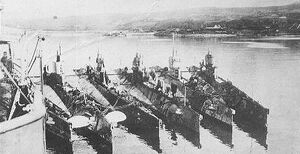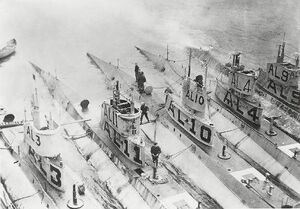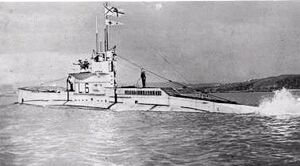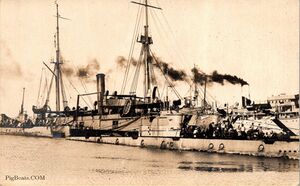General L-boat photos: Difference between revisions
Pbcjohnston (talk | contribs) mNo edit summary |
Pbcjohnston (talk | contribs) Added photo |
||
| Line 36: | Line 36: | ||
After the boats arrived in the war zone in Ireland, the USN found that the British Royal Navy was also operating submarines in the area that were coincidentally called the L-class. Wanting to avoid problems in visually identifying the two classes of similarly named boats, the USN added the letter “A” to the side of the conning tower fairwater to the left of the letter “L”. This gave all friendly navies in the area the ability to quickly distinguish between the two classes. Contrary to popular belief, the boats WERE NOT officially renamed AL-3, AL-10, etc. on the Navy List or in any official Navy documents. They retained their original names and hull numbers for the duration of their service lives. The A’s were added when they arrived in the war zone and removed shortly after the conclusion of the war and the boat’s return to the states. It was a temporary visual expedient and nothing more. As an example, this boat is the HMS L6. | After the boats arrived in the war zone in Ireland, the USN found that the British Royal Navy was also operating submarines in the area that were coincidentally called the L-class. Wanting to avoid problems in visually identifying the two classes of similarly named boats, the USN added the letter “A” to the side of the conning tower fairwater to the left of the letter “L”. This gave all friendly navies in the area the ability to quickly distinguish between the two classes. Contrary to popular belief, the boats WERE NOT officially renamed AL-3, AL-10, etc. on the Navy List or in any official Navy documents. They retained their original names and hull numbers for the duration of their service lives. The A’s were added when they arrived in the war zone and removed shortly after the conclusion of the war and the boat’s return to the states. It was a temporary visual expedient and nothing more. As an example, this boat is the HMS L6. | ||
[[File:Alert w L-boats CZ-1.jpg|left|thumb]] | |||
Revision as of 15:58, 14 April 2023

A small photo of three L-boats at an unknown location, probably in the spring or summer of 1916. This is definitely a pre-WWI photo, as these boats do not have the installed "chariot" style bridge structures.

Six L-class boats moored outboard of their tender in Queenstown, Ireland, summer of 1918. Left to right is L-3, L-11 (with bow planes rigged out), L-10, L-4, L-9, and L-2.

A slightly later photo than the one above, taken in the late summer of 1918 in Queenstown, Ireland. L-3, L-11, L-10, L-4, and the L-5. An accumulation of war experience is evident in this photo, as the boats have had the semi-permanent "chariot" style bridge structures added. The structure on L-10 seems rather small, and it is possible that she has yet to receive the larger structure. The letter A added to their names was a temporary expedient that was carried only while the boats were in theater in Europe. They were removed almost immediately after their return to the States. The post like object sticking up above the deck forward of the conning tower fairwater is the retracted 3"/23 caliber Mk 9 deck gun.

After the boats arrived in the war zone in Ireland, the USN found that the British Royal Navy was also operating submarines in the area that were coincidentally called the L-class. Wanting to avoid problems in visually identifying the two classes of similarly named boats, the USN added the letter “A” to the side of the conning tower fairwater to the left of the letter “L”. This gave all friendly navies in the area the ability to quickly distinguish between the two classes. Contrary to popular belief, the boats WERE NOT officially renamed AL-3, AL-10, etc. on the Navy List or in any official Navy documents. They retained their original names and hull numbers for the duration of their service lives. The A’s were added when they arrived in the war zone and removed shortly after the conclusion of the war and the boat’s return to the states. It was a temporary visual expedient and nothing more. As an example, this boat is the HMS L6.
